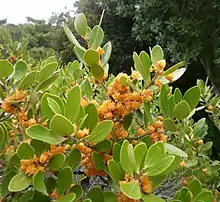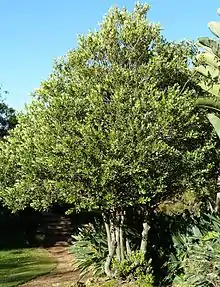Pterocelastrus tricuspidatus
Pterocelastrus tricuspidatus, commonly called candlewood, cherrywood or kershout, is a medium-sized evergreen tree, indigenous to South Africa.
| Pterocelastrus tricuspidatus | |
|---|---|
 | |
| Scientific classification | |
| Kingdom: | Plantae |
| Clade: | Tracheophytes |
| Clade: | Angiosperms |
| Clade: | Eudicots |
| Clade: | Rosids |
| Order: | Celastrales |
| Family: | Celastraceae |
| Genus: | Pterocelastrus |
| Species: | P. tricuspidatus |
| Binomial name | |
| Pterocelastrus tricuspidatus | |
Distribution
The candlewood is indigenous to the southern part of South Africa. Here it naturally occurs from Cape Town in the west, all the way along the south coast of South Africa as far as KwaZulu-Natal. In this range it can be found in most soil types, from coastal sand to rocky mountain slopes and clay.
Description

In the wild it often grows as a stunted bush (especially in exposed positions). However if permitted to by favourable conditions, it can grow into a tree of up to 10 meters in height.
The masses of sweetly scented flowers are followed by large numbers of very distinctive and attractive bright-orange, lantern-shaped berries. The young leaves are red, but mature to a glossy green colour.
Cultivation
In cultivation the candlewood can be pruned to form a proper shade tree. However, it can also be allowed to grow as a bushy screen, if its lower branches are not removed. This plant grows particularly well in coastal conditions (although it can also be found inland).
Its primary reason for cultivation are as a coastal hedge, and for its ornamental bright orange, lantern-shaped berries, which attract birds.
The candlewood tree tolerates drought and severe frost once it is established. [1] [2]
| Wikimedia Commons has media related to Pterocelastrus tricuspidatus. |
References
- "Pterocelastrus tricuspidatus | PlantZAfrica.com". www.plantzafrica.com. Retrieved 2017-08-04.
- "Archived copy". Archived from the original on 2012-10-10. Retrieved 2012-10-15.CS1 maint: archived copy as title (link)